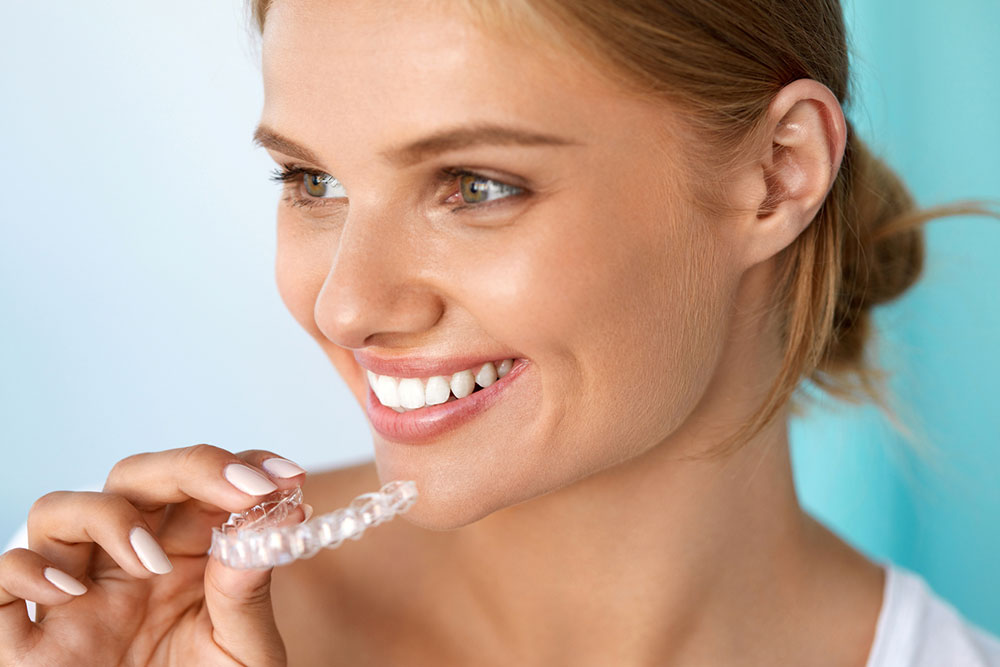Invisible dental aligners – Benefits and tips to follow

A well-aligned, healthy set of teeth enhances one’s smile considerably. These days, many people prefer to use teeth aligners for their aesthetic benefits and to avoid gum inflammation and other related issues that could arise from misaligned teeth. Also, misaligned teeth can sometimes be difficult to clean, leading to other dental problems. Wearing invisible aligners is a popular option today as they are not easily visible but are still effective in aligning the teeth.
What are invisible dental aligners?
Invisible dental aligners are transparent teeth clips that orthodontists may prescribe to straighten one’s teeth so that they are better aligned. They’re usually made of clear plastic or acrylic, so they fit comfortably on the teeth and need to be removed when one is eating, flossing, or brushing.
Benefits of invisible dental aligners
- Esthetically pleasing
Since invisible dental aligners are transparent, they are not visible on the teeth’s surfaces, unlike metal braces. So, they do their job of aligning one’s teeth while not compromising on aesthetics. - Comfortable and painless
Many people don’t prefer metal braces because they have sharp edges that may hurt one’s cheeks and lips. On the other hand, dental aligners are relatively painless and slip in comfortably. These aligners have smooth edges, so one’s gums and cheeks don’t hurt when they have them on. - Easily removable
Usually, dental braces cannot be removed easily once they are fastened to the teeth, but that’s not the case with invisible aligners. These dental aligners can be removed easily without the help of a dentist, so one can comfortably remove them before meals, or while brushing, and put them back on later. This way, one can ensure that food particles don’t get lodged in the braces and that one has good dental hygiene. - Minimally invasive
Another advantage of invisible dental aligners is that the procedure to put them on is not invasive, so there is minimal discomfort after and during the procedure. - Easy to clean and maintain
Since dental aligners are easily removable, they can be cleaned daily so that no dust or food particles remain on them. - Highly customized
Traditional braces fall into the one-size-fits-all category, but dental aligners are highly customized to suit the user’s requirements. These are custom-made based on the user’s teeth and bite, so they cater to one’s specific needs much better than other braces.
Tips to follow when opting for invisible dental aligners
Be financially prepared
Invisible dental aligners may cost anywhere from $2,000 to $10,000, but the premium-quality ones are usually on the higher end of this range. But these aligners are so expensive because they are tailor-made for every person based on each one’s teeth and bite. This customization is a major advantage. If one understands the expenses involved and makes an effort to start saving up beforehand, one may be able to opt for dental aligners comfortably. So, it is best to calculate the exact expenditure involved and be financially prepared well in advance when opting for invisible dental aligners.
Remember to remove them when eating, and brushing
Dental aligners can easily develop stains, so they should be avoided when in contact with food. So, it is important to take the aligners off before every meal. Also, since they are easily removable, one should remember to take them off when brushing and flossing to maintain oral hygiene.
Keep them on for at least 20 hours a day
Even though dental aligners can be removed easily, they need to be worn for at least 20 hours a day to bear good results. If one takes them off during the day, one should always put them back on to make the aligners effective.
Preserve the aligners carefully when not in use
Since dental aligners need to be removed from time to time, there is a possibility that they might get misplaced or damaged. It is important to have a dedicated spot to store the aligners when they are not in use. Also, they should never be placed on the loose – one should designate a box or pouch to place them in so they are not vulnerable to wear and tear.
Consult a reliable orthodontist before using aligners
One should always consult an orthodontist before buying invisible dental aligners, even though they may be worn independently. This is because an orthodontist can examine a person’s teeth and suggest the best type of aligners based on one’s teeth and bite and alignment issues. When looking for an orthodontist, one should check their credentials, experience, and specialization in teeth alignment, check reviews, and speak with family members, and friends about the dentist’s credibility.
Understand that there will still be slight discomfort
Dental aligners are far more comfortable and painless than traditional braces. However, they are also external agents on the teeth, so it is natural to experience discomfort when one has them on, especially at the start. Being mentally prepared only makes the process easier and more hassle-free.
Clean the aligners regularly
One major advantage of aligners is that they can be removed and cleaned. One should make the best use of this feature by cleaning one’s aligners regularly. If aligners aren’t cleaned, any stains or particles lodged in them become visible, defeating the purpose of wearing invisible aligners.

